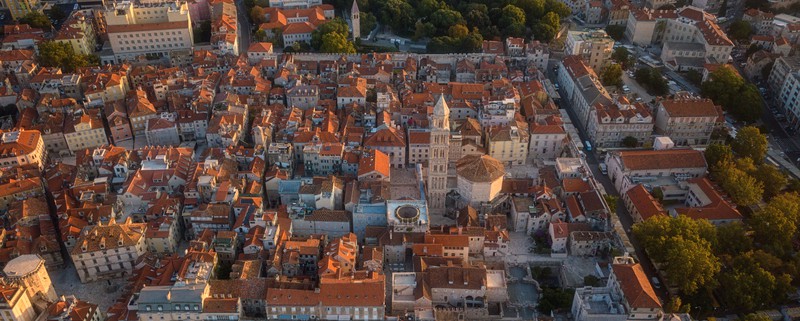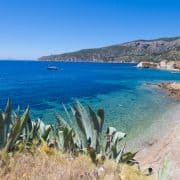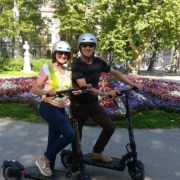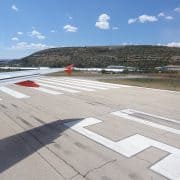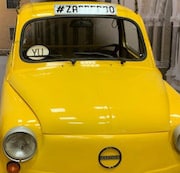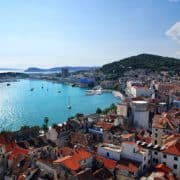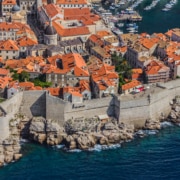Spotlight on: Diocletian’s Palace, Split
One of the most famed sights in Croatia, the Diocletian’s Palace area in Split is also one of the most historic sights you may visit on your travels. It is an absolute must-see and contains many individually interesting elements to explore. The whole area, right at the very core of the city, is also a thoroughly enjoyable part of Split with numerous cafes, restaurants, bars, shops and more. You’ll be strolling around taking in a whole tonne of history whilst also getting so much of what Split has to offer.
The “Historical Complex of Split with the Palace of Diocletian” was declared a UNESCO World Heritage in 1979. (It was one of Croatia’s first; Dubrovnik’s Old Town and the Plitvice Lakes were also added to the list in the same year.)
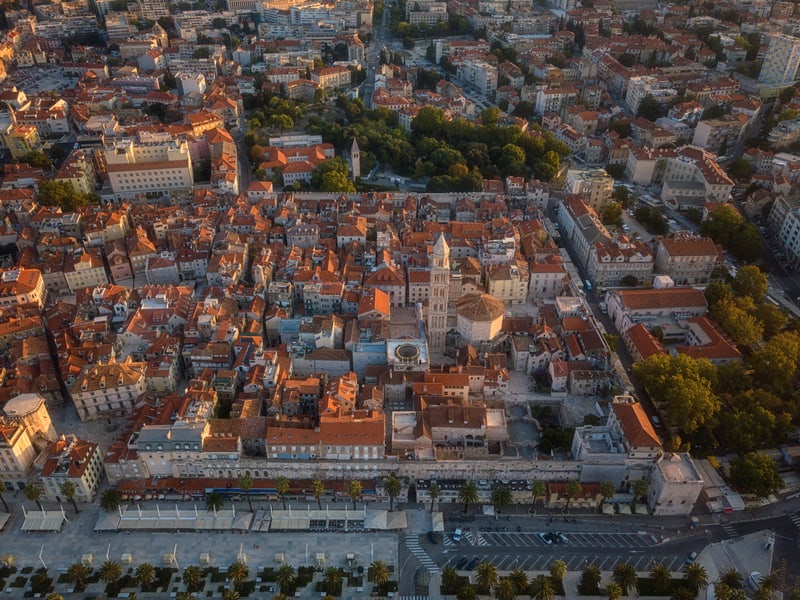
About Diocletian’s Palace and History
If you don’t yet know much about Diocletian’s Palace, you might consider Dioletina’s retirement home to be like any typical European palace structure. In your head, you may be considering an extremely large and ornate building, perhaps set in large, highly manicured grounds and full of rather ostentatious furniture.
Diocletian’s Palace is nothing like that! (At least not today; the palace may well have had some of these components all those many centuries ago.)
The palace was built as a retirement home (yes, really) for Roman Emperor Diocletian who was born in Salona (now present-day Solin) sometime between the years 242 to 245. He retired from Emperor life in the year 305 and lived in the palace until his death in 311. Work on constructing the palace is though to have begun in the year 295 with materials from local sources used – particularly white limestone from Brac and bricks made locally. You can see below what the structure would have looked like around the time of its competition – you can see that the palace did indeed stretch all the way out to the sea.

Diocletian’s Palace. (2024, February 8). In Wikipedia. https://en.wikipedia.org/wiki/Diocletian%27s_Palace
The Palace was built in a rectangular shape of roughly 215 metres by 180 metres. There were towers at each corner of the Palace and octagonal towers framing each entrance into the Palace. The area of the structure was divided into four with two main “streets” within. The southern gate would have been the Emperor’s main entry into the Palace by sea and, indeed, the southern part of the Palace would have contained his residence whilst the northern part would have contained quarters for servants and guards.
After Diocletian’s death, the Palace continued to be used by members of the emperor’s family. It rose in importance again in the 7th century when Salona (Solin), once the capital of Dalmatia and a large (for that time) city was destroyed by an invasion by the Slavs that had by now reached this area. Some of the previous inhabitants of Salona sought shelter and refuge in the large Palace area, and Palace life – now city life – began to resume. In the many years since citizens have continuously lived within what is deemed to be the Palace area and adapted its use multiple times.
Getting There
The Diocletian’s Palace area is just by the Riva, the main harbourfront in Split. It is a short walk from the main bus and train stations and port in the city (which are all adjacent to each other), about 10 minutes.
Should you be travelling from further afield in Split, there are numerous local bus lines that stop near the Palace. You can check out Split’s bus network on the Promet Split website.
What to See and Do at Diocletian’s Palace
You really could get lost whilst wandering the streets of the Palace…but try not to! In all seriousness, the best way of seeing the Palace is to go back and forth through its many little streets taking in all the many sights and experiences. Below are some of the main things to look out for and see.
Gates
As you approach the Palace area, you’ll no doubt enter through to the main part via one of the gates. As we’ve mentioned, the southern gate – the Brass Gate – would have once been the main entrance from the sea and is the smallest of all the gates. Today, this gate allows you entry from the Riva. On the eastern side is the Silver Gate which was reconstructed in 1952 after Dusica Church was destroyed during World War II; the gate had become part of the Church during its construction.
On the northern side, right by the large Grgur Ninski (Gregory of Nin) statue is the Golden Gate (Zlatna vrata) which would have faced the direction of Salona and would have been the main entrance into the Palace.
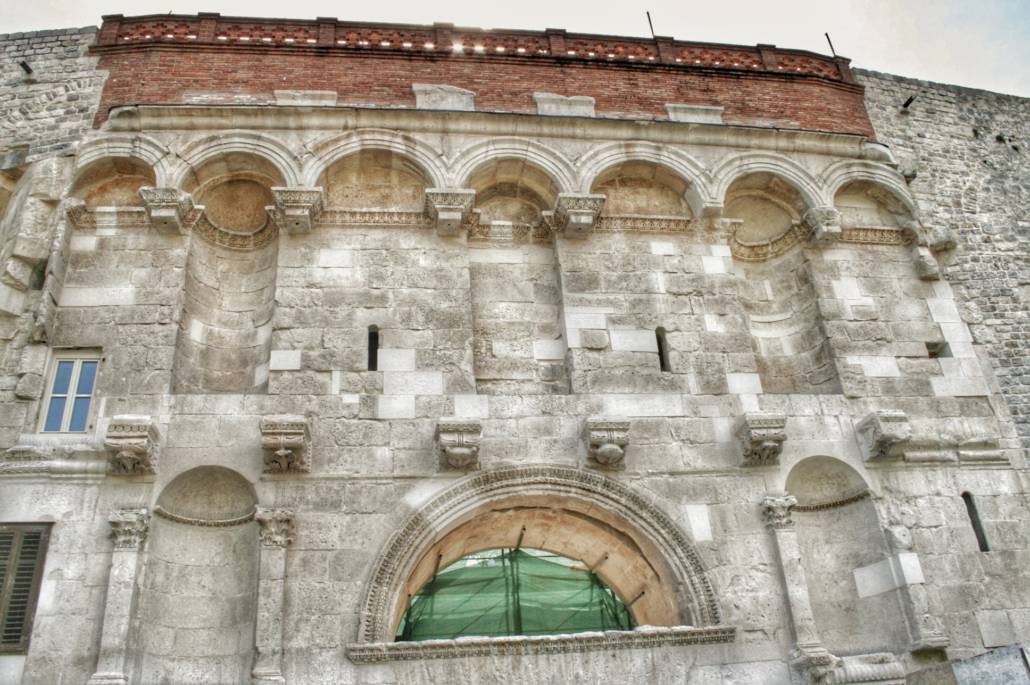
On the eastern side is the Iron Gate which is the only gate of the four that has seen continuous use since it was first constructed.
The Cathedral of Saint Domnius and Belltower
The octagonally-shaped Cathedral of St Domnius (Katedrala Svetog Duje in Croatian) is the oldest Catholic cathedral in the world in its original structure, consecrated as it was in the 7th century. The Cathedral contains the 3rd-century mausoleum for Emperor Diocletian whilst the belltower was a later addition, built in the 13th century. Diocletian’s sarcophagus was destroyed in the 5th century
The 57-metre-tall belltower can be climbed for superb views over Split in all directions including out over the twinkling Adriatic Sea.
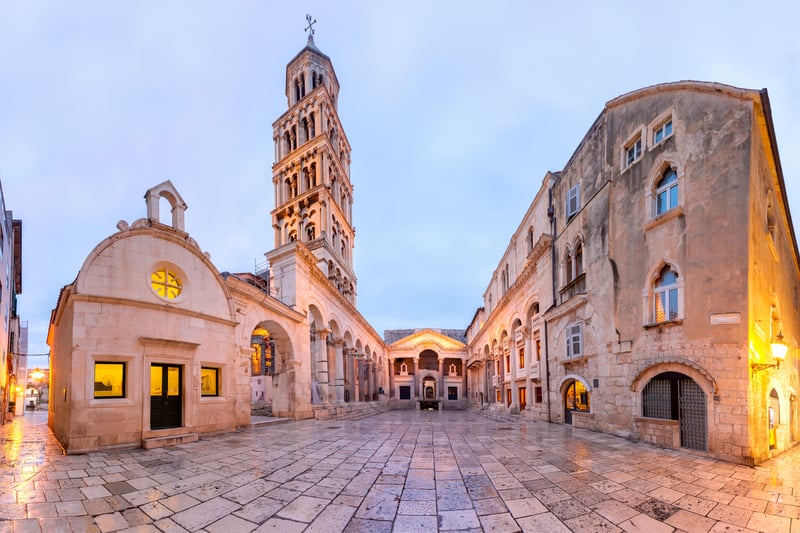
Temple of Jupiter
By the entrance of this former temple is another 3,500-year-old Egyptian sphynx, this one being headless. The Temple itself was converted into a Baptistry dedicated to St John the Baptist in the 6th century. The Temple contains sarcophagi with the remains of Ivan of Ravenna and Lovre, both Archbishops of Split in the 11th century. You will also find a bronze statue of St John the Baptist created by famed Croatian sculptor Ivan Mestrovic.
The Peristyle
The Peristyle is a remarkable open-air square which would have been the main square of the Palace even way back when. Consider this as you sip on a relaxing coffee on the stone steps whilst admiring the view. The Peristyle is also home to a 3,500-year-old Egyptian sphynx.
The Vestibule
The inside of the vestibule is circular, and you’ll notice the circular open-air top which was once covered by a dome. The vestibule was a hall in the days of the Palace, serving as an entrance to the Palace apartments. These days you come across traditional acapella singers (singing klapa music) who make use of the excellent acoustics in the Vestibule.
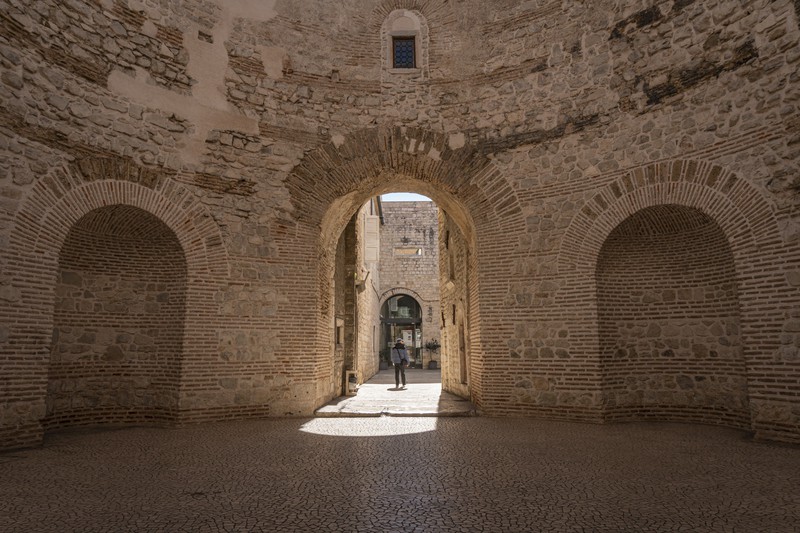
Cellars
The cellars were originally used as storage areas when the Palace was first built. The importance of the cellars is because they are so well preserved and provide and excellent idea of what the above-ground portion of the Palace would have been like.
Part of the cellar area can be easily visited as you pass through the Brass Gate from the Riva towards the direction of the Vestibule and the Peristyle. You will find numerous little market stalls selling souvenirs and other trinkets.
Access to the rest of the cellars is ticketed (see below).
Opening Hours and Entrance Price
The main Palace area is free to enter at all times of day and night, year-round, and there is no fee to enter, of course!
Parts of the Palace, however, do have an entrance fee and particular opening times.
All parts of the Cathedral, including the Belltower, require tickets to enter.
Part of the cellars that are ticketed are open 8.30am – 8pm (summer hours, April to October) or 9am to 5pm (winter hours, November to March). Tickets cost €8 for adults and €6 for children aged 7 to 14, seniors (aged 65 and over) and students with ID. Children aged 6 and under can enter for free. You can buy tickets at the ticket booth in the Palace or on the Museum of the City of Split website.
Other Ways of Seeing and Enjoying Diocletian’s Palace
If you’d like to step back in time – virtually – and see for yourself what Diocletian’s Palace would have been like all those many centuries ago, head to the Diocletian’s Dream experience. Don a VR headset and immerse yourself in Split life in the year 305.
There are numerous walking tours of the Diocletian’s Palace area that you can join; led by knowledgeable guides, the tours will really give you an expansive information base from which to learn all about the Emperor and his retirement home. Take a look at some of the tours below:
More info
You can read more about the Palace on the Split Tourist Board website.

